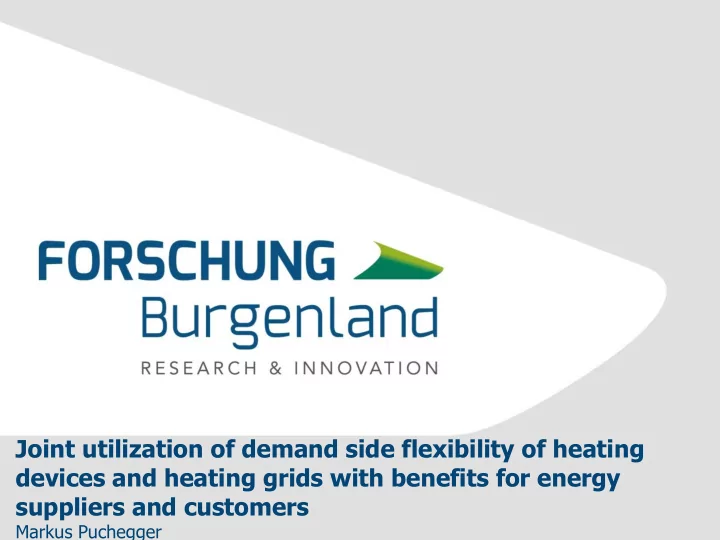

Joint utilization of demand side flexibility of heating devices and heating grids with benefits for energy suppliers and customers Markus Puchegger
Agenda Introduction Observed network area Optimization of heating devices in households Optimization of heating grid Investment considerations Conclusion
Introduction – role of thermal flexibilities What can 1 kWh do? How high the mass of 1 t can be lifted? 𝑋 => ~367 m 𝑋 = 𝑛 ∙ ∙ ℎ bzw. 𝑛∙ = ℎ To which speed the mass of 1 t can be accelerated? => ~ 85 m/s 1 2∙𝑋 𝑋 = 2 ∙ 𝑛 ∙ 𝑤² bzw. 𝑤 = ~ 306 km/h 𝑛 How many degrees 1 m³ of water (~ 1 t) can be warmed/heated up? 𝑋 𝑋 = 𝑛 ∙ 𝑑𝑞 ∙ 𝑒𝑈 bzw. 𝑛∙𝑑𝑞 = 𝑒𝑈 => ~0.86°K
Introduction – existing thermal flexibilities Thermal storage capacity of concrete: 2.200 kJ/m³K e.g. with 100 m² concrete: ~0.4-0.8 m³/m² living space 21.000 – 42.000 l Thermal storage capacity of building 90 – 180 MJ/K
Introduction - conclusions temperature change of existing thermal masses have a high potential for energy storage for facilitation of these potential for the electrical system it is necessary to use/create more linking points from electricity to thermal facilities/applications – PtH in every form to act system benificial, PtH-facilities and -applications have to be intelligent and interconnected (part of the smart grid) (economic) incentives have to be found to facilitate existing PtH-applications for optimization Business cases for new PtH-applications should be found
The observed network area not district relevant heating boiler house Grid area electric heat (electricity and generation heating)
Optimization of heating devices in households within the limits of the heat storage simulation in 15-min time steps for each type of household
Optimization of heating devices in households Number of Surplus for all Surplus for Average Surplus per Surplus per Type of households household supplier Overall overall household for household household within this within this within this surplus surplus per customer for supplier type type type household [-] [€/a] [€/a] [pcs] [€/a] [€/a] [€/a] [€/a] DW-1 0 10.51 1,409 0 14,808.59 14,808.59 10.51 DW-2 0 51.64 183 0 9,450.12 9,450.12 51.64 DW-3 0 68.42 183 0 12,520.86 12,520.86 68.42 DW-4 0 106.21 853 0 90,597.13 90,597.13 106.21 SFH-1 0 56.70 32 0 1,814.40 1,814.40 56.70 SFH-2 0 70.69 32 0 2,262.08 2,262.08 70.69 SFH-3 0 103.85 144 0 14,954.40 14,954.40 103.85 SFH-4 75.49 60.81 4 301.96 243.24 545.20 136.30 SFH-5 76.11 80.84 4 304.44 323.36 627.80 156.95 SFH-6 182.47 272.48 16 2,919.52 4,359.68 7,279.20 454.95 SFH-7 0 25.83 169 0 4,365.27 4,365.27 25.83 SFH-8 22.41 20.08 19 425.79 381.52 807.31 42.49 Sum baseline 3,048 3,951.71 156,080.65 160.032,36 52.50 Sum PV expansion 3,048 11,050.20 158,411.62 169,461.82 55,59 scenario
Optimisation of heating grid within the limits of the heat storage simulation in 15-min time steps System efficiency for PtH 𝜻 𝒕𝒛𝒕 = 𝟐 Electric direct heating: 𝜻 𝒕𝒛𝒕 = 𝟑 High temperature heat pump: Wholesale prices for wind feed in without promotional tariffs would have been 29.36 €/MWh exluding balancing costs arising from wind energy 24.51 €/MWh including balancing costs arising from wind energy Alternative heat generation costs were varied between 40 and 80 €/MWh
Optimization of heating grid PtH Dimensioning PtH by wind PtH by PV surplus PtH by wind + PV surplus
Money savings through PtH per year using wholesale market price for wind and PV-surplus Money savings through PtH per year using wholesale market price for wind and PV-surplus including network charges Annual money savings through PtH using a heat pump applying wholesale market prices for wind and PV-surplus, including network charges
Investment considerations - households
Investment considerations – heating grid / household optimation 2 MW wind + PV SP 6 MW wind + PV SP 500 kW PtH boiler 500 kW PtH heat pump no network charges incl. network charges 2 MW wind + PV SP 6 MW wind + PV SP 500 kW PtH boiler 500 kW PtH heat pump no network charges incl. network charges
Conclusions Optimization in households has to be done by a low cost approach or with another added value (e.g. building automation) Target costs for PtH are strongly connected with the scenario and the PtH-technology High amount of connected wind power leads to higher savings per year for heating grid High common heat generation costs are positive for PtH-solutions For PtH-solutions which has to pay network charges, the efficiency of the PtH-device should be higher than 1 (usage of heat pumps) For investment decisions, detailed planning and estimation of future prices (energy, network charges) is necessary
THANK YOU! Research Burgenland GmbH DI Markus Puchegger Researcher Steinamangerstraße 21 7423 Pinkafeld Phone: +43 5/7705-5434 Mobile:+43 664 16 16 656 Fax: +43 3357 45370 1011 E-Mail: markus.puchegger@forschung-burgenland.at Web: www.forschung-burgenland.at/en/
Recommend
More recommend